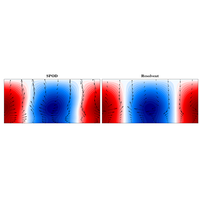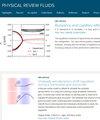Coherent pressure structures in turbulent channel flow
IF 2.5
3区 物理与天体物理
Q2 PHYSICS, FLUIDS & PLASMAS
引用次数: 0
Abstract
Most of the studies on pressure fluctuations in wall-bounded turbulent flows aim at obtaining statistics as power spectra and scaling laws, especially at the walls. In the present study we study energetic coherent pressure structures of turbulent channel flows, aiming at a characterization of dominant coherent structures throughout the channel. Coherent structures are detected using spectral proper orthogonal decomposition (SPOD) and modeled using resolvent analysis, similarly to related works dealing with velocity fluctuations but this time using pressure fluctuations as the output of interest. The resolvent operator was considered with and without the Cess eddy-viscosity model. Direct numerical simulations (DNSs) of incompressible turbulent channel flows at friction Reynolds numbers of approximately 180 and 550 were employed as databases in this study. Three representative dominant structures emerged from a preliminary spectral analysis: near-wall, large-scale, and spanwise-coherent structures. For frequency–wave number combinations corresponding to these three representative structures, SPOD results show a strong dominance of the leading mode, highlighting low-rank behavior of pressure fluctuations. The leading resolvent mode closely agrees with the first SPOD mode, providing support to studies that showed better performance of resolvent-based estimators when predicting pressure fluctuations compared to velocity fluctuations [Amaral et al., J. Fluid Mech. 927, A17 (2021)]. The dominant mechanisms of the analyzed modes are seen to be the generation of quasistreamwise vortices with pressure fluctuations appearing close to vortex centers. A study on the individual contributions of the nonlinear terms (treated as forcing in resolvent analysis) to the pressure output reveals that each forcing component plays a constructive role to the input-output formulation, which also helps understanding the weaker role of forcing “color” in driving pressure fluctuations.

紊流通道流中的相干压力结构
大多数关于壁面湍流压力波动的研究都旨在获得功率谱和缩放规律等统计数据,尤其是在壁面上。在本研究中,我们对湍流通道流的高能相干压力结构进行了研究,旨在确定整个通道中主要相干结构的特征。相干结构通过光谱正交分解(SPOD)进行检测,并通过解析分析进行建模,这与处理速度波动的相关工作类似,但这次将压力波动作为感兴趣的输出。在使用和不使用 Cess 涡粘度模型的情况下都考虑了解析算子。本研究采用了摩擦雷诺数约为 180 和 550 的不可压缩湍流通道流的直接数值模拟(DNS)作为数据库。通过初步频谱分析,得出了三种具有代表性的主要结构:近壁结构、大尺度结构和跨度相干结构。对于与这三种代表性结构相对应的频率-波数组合,SPOD 结果显示前导模式占主导地位,突出了压力波动的低阶行为。前导分解模态与 SPOD 第一模态密切吻合,这为一些研究提供了支持,这些研究表明,与速度波动相比,基于分解模态的估算器在预测压力波动时具有更好的性能[Amaral 等人,J. Fluid Mech.分析模式的主要机制是产生准流向涡旋,压力波动出现在涡旋中心附近。对非线性项(在解析力分析中被视为强迫)对压力输出的单独贡献的研究表明,每个强迫成分都对输入输出公式起着建设性作用,这也有助于理解强迫 "颜色 "在驱动压力波动中的较弱作用。
本文章由计算机程序翻译,如有差异,请以英文原文为准。
求助全文
约1分钟内获得全文
求助全文
来源期刊

Physical Review Fluids
Chemical Engineering-Fluid Flow and Transfer Processes
CiteScore
5.10
自引率
11.10%
发文量
488
期刊介绍:
Physical Review Fluids is APS’s newest online-only journal dedicated to publishing innovative research that will significantly advance the fundamental understanding of fluid dynamics. Physical Review Fluids expands the scope of the APS journals to include additional areas of fluid dynamics research, complements the existing Physical Review collection, and maintains the same quality and reputation that authors and subscribers expect from APS. The journal is published with the endorsement of the APS Division of Fluid Dynamics.
 求助内容:
求助内容: 应助结果提醒方式:
应助结果提醒方式:


